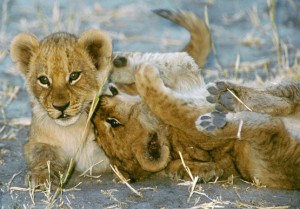News
Latest Lion Aid News
Another nail in the coffin for "sustainable lion hunting"
Saturday 23rd March 2013
|
Who’s your daddy? Those who promote the concept that lions can be hunted sustainably claim that males older than 6 yrs can be shot without consequence – after all they have already reproduced by that age, and can then be classified as “excess males”. I have always had problems with such theories based on Serengeti studies and computer models. When I studied lions for eleven years in the Okavango Delta of Botswana it was clear that males do not even begin to think about taking over prides until they are about 5-6 yrs, and after their initial reproductive period within “their” pride they begin exploring neighbouring pride territories. If they find females in oestrus during their explorations they will mate with them. Males often voluntarily abandon prides and take over others where there are more reproductively receptive females. Male coalitions are fluid, and older males evicted from prides will often join up with younger males to form new coalitions and take over other prides. Careful studies have shown that this model of male reproductive flexibility occurs in many other areas besides the Okavango, and that a male lion’s reproductive potential encompasses much more than an initial chance. The Serengeti research, based on outdated genetic techniques liable to misinterpretation of results, insists that all cubs born in a pride belong to the pride males. And that males take over a pride when they are 4 yrs old, and once they are replaced by new males two years later, have no further reproductive opportunities. Hence they become “excess males” that sadly wander the savannas for the rest of their lives – so they might as well be shot by trophy hunters to put them out of their misery. What is equally sad is that such highly questionable “information” on male lion reproduction has been accepted as gospel by trophy hunters and that such hunters and their supporting “scientists” actually believe in the concept of “excess males”. Now there is genetic paternity evidence that all is not well with such absurd theories. In an article in Molecular Ecology, researchers found that in Etosha National Park in Namibia, “extra-group paternity”(EGP) (cubs sired by males other than the pride males) occurred in 57% of the prides examined, and the rate of EGP in those prides was 41% (meaning over 4 of every ten cubs had a father that was not a pride male). This is consistent with observations made in my Okavango study and casts severe doubt on the concept of “excess” males with no reproductive potential. Basically, all male lions have reproductive potential with and in addition to their pride females. Lions have a complex society that cannot be simply defined by what trophy hunters want to believe, and such data once again puts into question the whole concept of “sustainable” hunting. Picture credit: Chris Harvey http://bit.ly/ZIX7mx Please support us if you can to conserve the remaining fragile lion populations. Thank you.
Tags: lions, trophy hunting, genetics, Categories: Genetics, Trophy Hunting |
Posted by Pieter Kat at 13:54
No comments have been posted yet.
Add a new comment
Existing user
New user sign up




